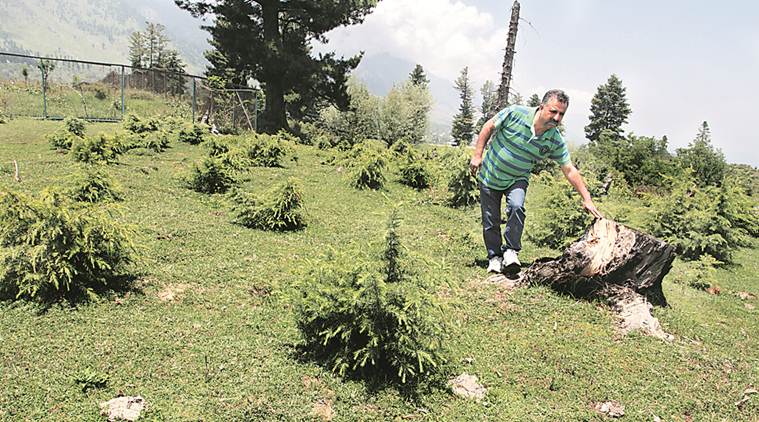AMID THE swirling unrest in the Kashmir Valley, thousands of sturdy pine trees speak for the passion and commitment of a 51-year-old man from Batamaloo in Srinagar to a cause that is far from the spotlight. Abdul Hamid Bhat’s mission is to plant trees across Kashmir, which has witnessed large-scale deforestation especially in the rural areas. Over the last nine years, says the automobile businessman, he has helped plant over one lakh trees, mostly pine, across the Valley with his own funds.
So much so, that in these parts they call him Rahim Greens, after his father Abdul Rahim who “owned a big chunk of land on the outskirts of Srinagar and always spoke about the importance of trees to the environment”.
“My passion towards trees started over a decade ago. I had an office at Barzulla where the state government had planted dozens of pine trees on the pavements and left them unattended. Initially, I used to take care of them. At the time, I used to distribute diaries and calendars to my clients and officials to promote my business. It was then that the idea struck that I should, instead, started distributing saplings. I realised that for the cost on one diary and a calendar, I could get six-seven saplings. Soon, others started encouraging me and some volunteered to help me distribute saplings,” says Bhat.
“Many people have also offered financial help, but I raise all the funds for plantation from my own business. I don’t believe in crowd-funding or taking money from the government or NGOs. Every year, I spent Rs 2-3 lakh on trees,’’ he says.
Such is his love for trees that outside his plush office at Rangreth Industrial Estate, Bhat has planted rows of pines that have changed the landscape of what is essentially a hub for manufacturing units. “I am planting trees of different varieties. I see this as a common man’s social responsibility,’’ he says.
Bhat then pulls out pictures of a large, green patch in Satheran village on the foothills of the Tosamaidan forest range in central Kashmir’s Budgam district. According to him, the deforestation here coincided with the start of militancy in 1989, when villagers felled thousands of pine and kail trees nearby and the adjacent forest.
Until a few years ago, says Bhat, many households in Satheran owned a horse and an axe and engaged in timber smuggling, which had become a lucrative trade. “After the government start tightening the noose, local volunteers and environmentalists sought my assistance. With the help of local villagers and local volunteers, I have planted more than 5,000 trees in this area. Now, all these saplings have turned into young trees,” he says.
Today, the children of those who were involved in timber smuggling in Satheran are part of Bhat’s plantation drive. “It gives me great satisfaction when I see former timber smugglers and their children helping us plant trees. Many have left smuggling and now earn their livelihood by doing other jobs,” he says.
Initially, Bhat says, he planted trees on a “small scale”. “The first massive exercise began in 2010, when I planted almost 20,000 trees in different parts of Kashmir. To reach far-off places, I took help from the National Service Scheme (NSS), local volunteers and students of different schools. Initially, I used to get pine trees from the Forest department for Rs 2 each and chinar free of cost, now the rates have touched Rs 15 and it takes another Rs 15 for transportation and other expenses for each sapling,’’ he says.
In some villages, Bhat has distributed walnut trees to help the local economy. “Walnut trees are not only good for the environment but also generate good money once they mature,” he says.
According to Bhat, the consequences of deforestation in Kashmir have been disastrous.
“It was due to heavy deforestation in the upper reaches that the Kashmir had to face massive floods in 2014. Earlier, it used to take days for rain water to reach Srinagar, but after deforestation, the water fills our big rivers and water bodies within eight or nine hours. A good plantation in the upper reaches can save us from this natural disaster and environmental problems,’’ he says.
And so, between April and May every year, he is busy chalking out programmes with local schools and volunteers for his plantation drive. “My motto is to educate the new generation about the environment. I prefer plantation drives with students because for them, these trees become personal souvenirs,” says Bhat, a school dropout.
As for Bhat, the biggest joy is to find a sapling planted by him turn into a fully grown tree. “After planting trees, I return to those locations to see them. Now, I even see trees in my dreams,’’ he says.

